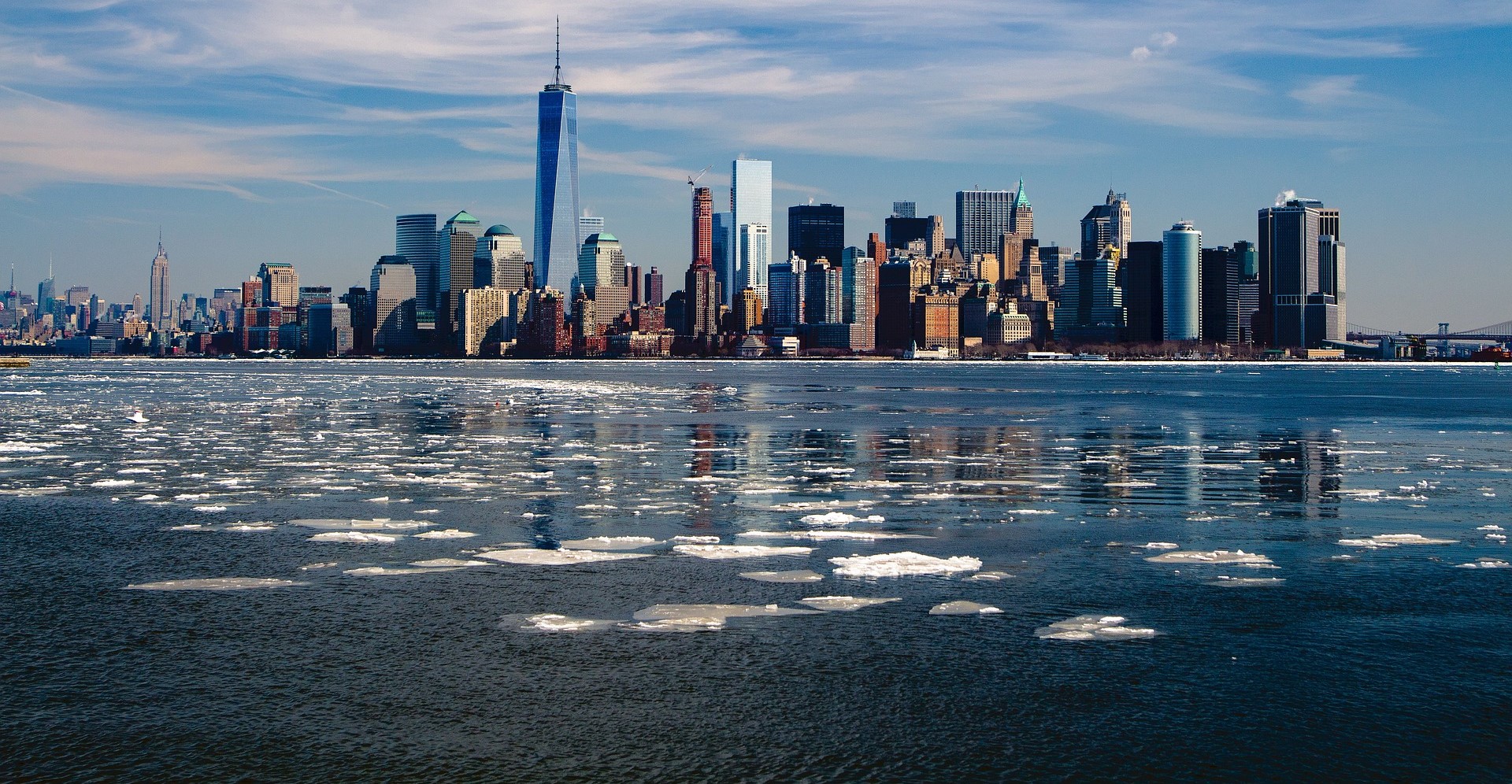AI Edition
Please check all the recent information about the attractions mentioned in this itinerary then plan the visit at your own pace.
New York City is a massive place with a seemingly endless array of attractions, eateries, and activities. Here is a three-day itinerary that hits some of the major highlights:
Day 1:
- Brooklyn Bridge
- South Street Seaport
- Wall Street
- 9/11 Memorial & Museum
- One World Observatory
- World Trade Center Station
In the morning, start your day with a walk across the iconic Brooklyn Bridge, enjoying views of the Manhattan skyline. On the Manhattan side, explore South Street Seaport, a historic area with unique shopping and dining options.

The Brooklyn Bridge is one of the oldest and most iconic suspension bridges in the United States. It connects the boroughs of Manhattan and Brooklyn, spanning the East River. The bridge was completed in 1883 and was the longest suspension bridge in the world at the time, with a main span of 1,595.5 feet (486.3 m).
The Brooklyn Bridge was designed by John Augustus Roebling, but after he was injured during the early stages of construction and subsequently died, his son, Washington Roebling, took over the project. Washington himself suffered a paralyzing injury due to decompression sickness, so his wife, Emily Warren Roebling, stepped in to assist in the completion of the bridge. Emily played a crucial role in the project, communicating her husband’s instructions to the workers and overseeing the construction.
The bridge’s distinctive Gothic-shaped towers, which are built of limestone, granite, and Rosendale cement, are truly iconic and have become a symbol of New York City. The Brooklyn Bridge also features a pedestrian walkway located above the traffic, where walkers and cyclists can cross the bridge while taking in views of the Manhattan and Brooklyn skylines.
Walking across the Brooklyn Bridge is a popular tourist activity and offers breathtaking views of the city. It’s about a 1.1-mile (1.8 km) walk and can take anywhere from 30 minutes to an hour, depending on your pace and how often you stop to take pictures or just enjoy the view. It’s especially beautiful at sunrise or sunset.
South Street Seaport is a historic area located where Fulton Street meets the East River, and adjacent to the Financial District. It’s part of the Manhattan borough of New York City.
The area is characterized by its old, beautiful buildings, some of which date back to the 18th century, cobblestone streets, and its maritime past. It’s known for its rich history, having been a major port in the city in the 19th century.
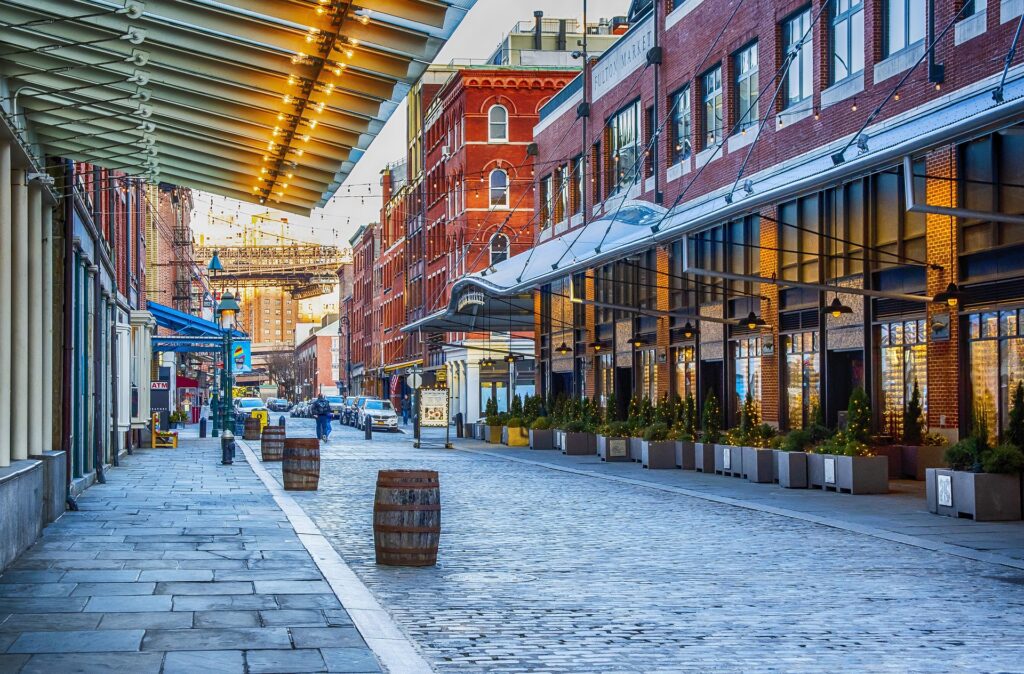
Image by Bruce Emmerling from Pixabay
The South Street Seaport Museum is a cultural institution dedicated to telling the story of the rise of New York as a port city and its critical role in the development of the United States. The Museum houses exhibition galleries, a working 19th-century print shop, an archeology museum, a maritime library, a craft center, a marine life conservation lab, and the largest privately-owned fleet of historic ships in the country.
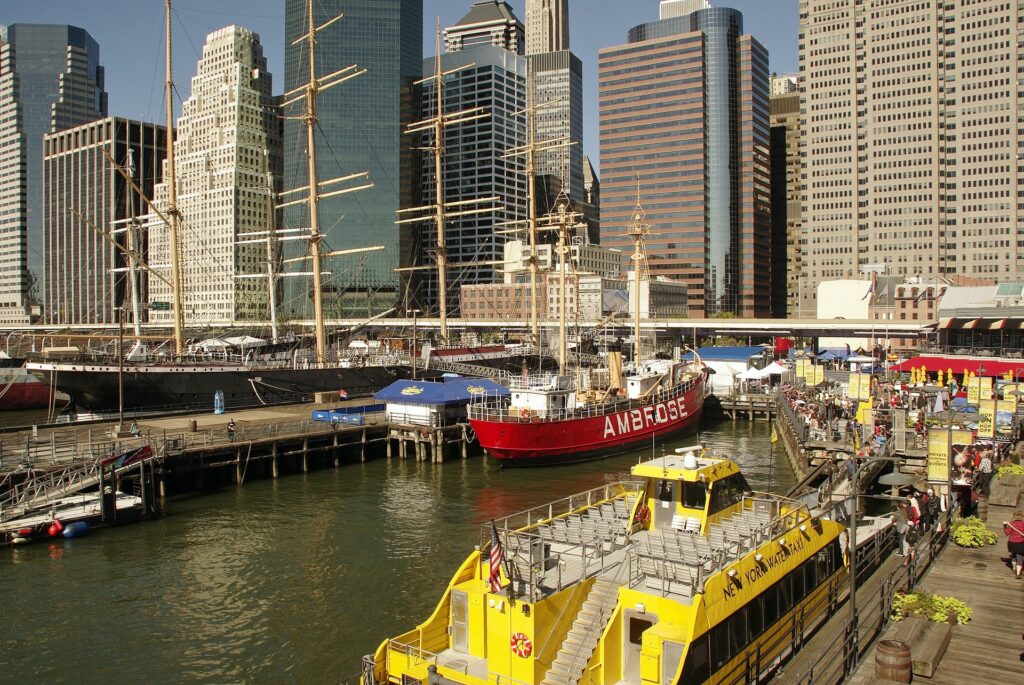
Pier 19 Image by DEZALB from Pixabay
The Seaport district also offers a wide array of shopping, dining, and entertainment options. You can find unique boutiques and shops, diverse eateries and bars, and even a vibrant nightlife scene.
The Pier 17 complex, located in the Seaport District, is a modern shopping and dining hub with a rooftop venue that hosts concerts and other events with stunning views of the Brooklyn Bridge and the East River.
In summary, South Street Seaport is a blend of the old and new, where historic buildings and modern developments coexist. It’s a place where you can appreciate New York City’s past while enjoying contemporary amenities.
In the late Morning, you can head to Wall Street and the Financial District. Don’t miss the Charging Bull statue, and maybe even take a quick peek at the New York Stock Exchange.
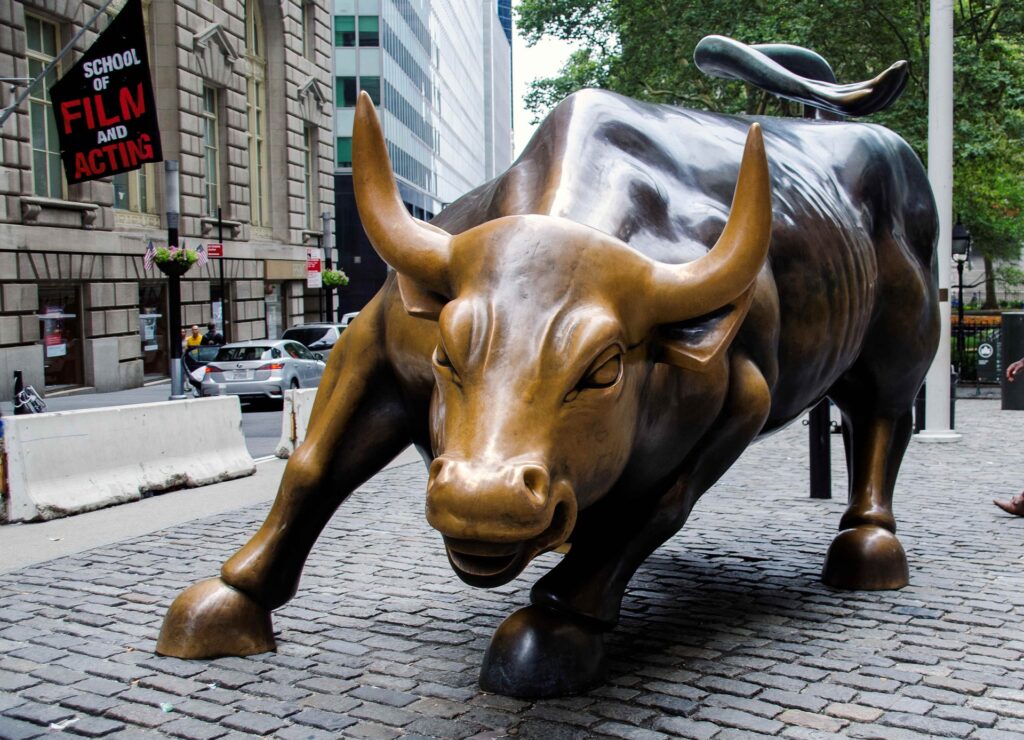
Bull Statue Image by Alexander Naumann from Pixabay
Wall Street is an iconic street in the Financial District of Lower Manhattan in New York City, and it’s synonymous worldwide with finance and major financial markets. Named after a long-gone wall that once ran along the street as a northern boundary for the Dutch settlement of New Amsterdam, Wall Street has been at the center of U.S. finance since the 19th century.
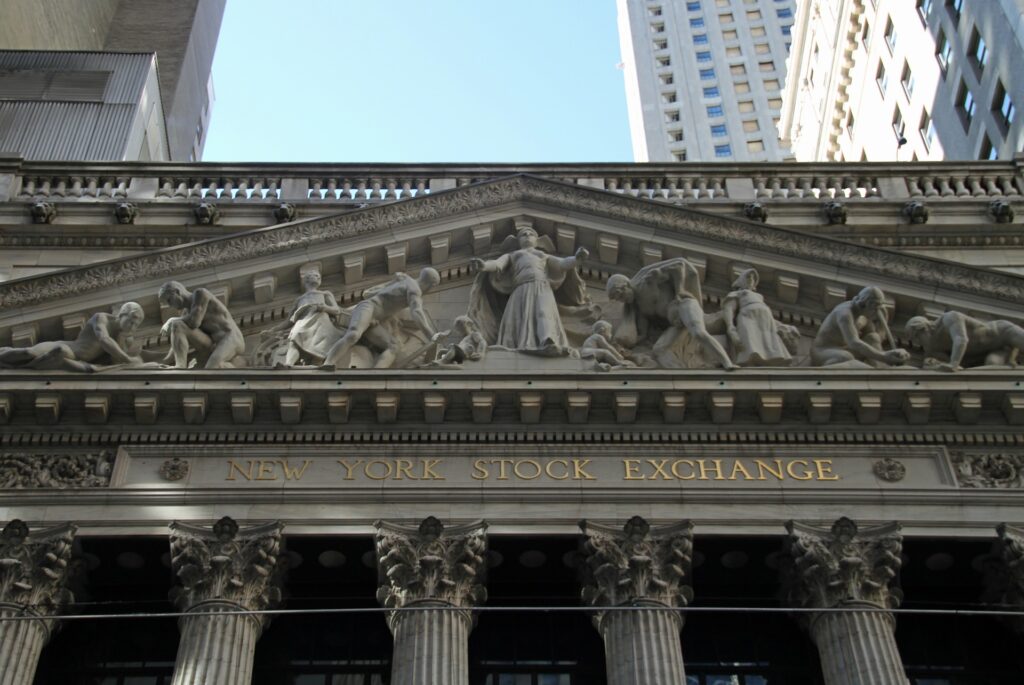
Image by Monica Volpin from Pixabay
Key attractions and landmarks on and near Wall Street include:
- New York Stock Exchange (NYSE): The world’s largest stock exchange by market capitalization of its listed companies. The classical facade, featuring six Corinthian columns and a marble pediment, is a globally recognized symbol of capitalism.
- Federal Hall: This is where George Washington was inaugurated as the first President of the United States. It’s now a museum and memorial to the first U.S. President and the beginnings of the United States of America.
- Wall Street Bull (Charging Bull): A bronze sculpture that stands in Bowling Green Park near Wall Street. It symbolizes financial optimism and prosperity.
- Trinity Church: One of the oldest and most historic churches in the United States. The adjoining Trinity Churchyard Cemetery is the final resting place for several historic figures, including Alexander Hamilton.
- The Fearless Girl Statue: This statue, which depicts a young girl standing with her hands on her hips, was installed opposite the Charging Bull to highlight gender inequality on Wall Street.

Image by maggavel from Pixabay
Wall Street is a bustling place during the week when the markets are open, filled with finance professionals and tourists alike. Many of New York’s subway lines converge nearby, making it easily accessible from throughout the city.
For your lunch, please grab the food you like at one of the nearby restaurants or food markets. You could check out Eataly in the nearby World Trade Center complex for a variety of Italian offerings.
In the afternoon, you can visit the 9/11 Memorial & Museum, a poignant tribute to the victims of the September 11 attacks.
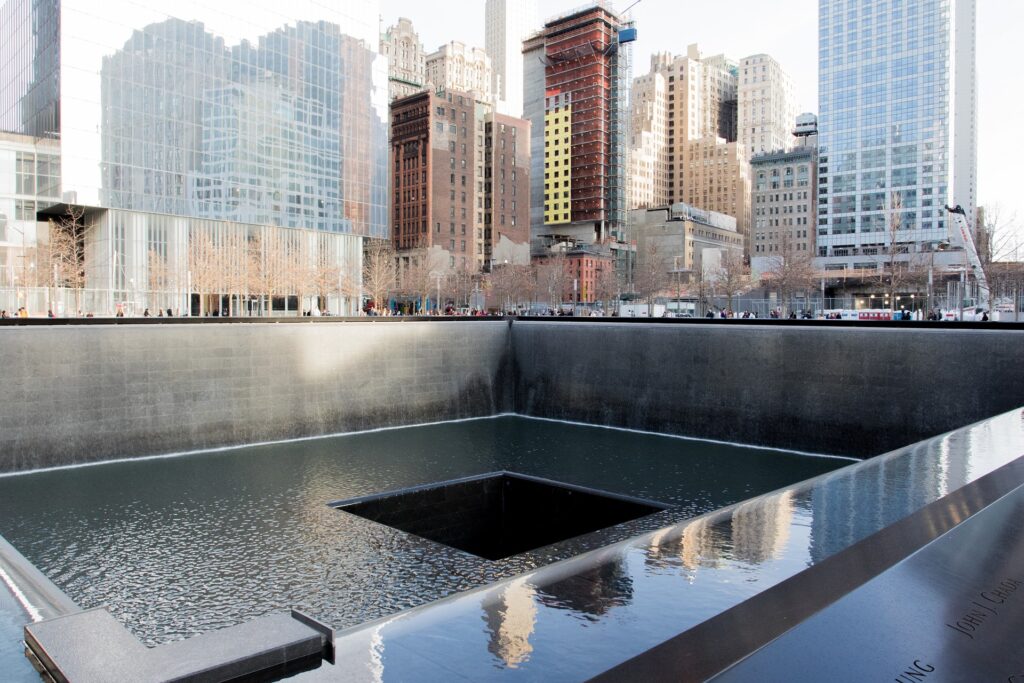
9/11 Memorial Pools Image by Foundry Co from Pixabay
The 9/11 Memorial Pools, officially known as the National September 11 Memorial & Museum, are a tribute to the nearly 3,000 people killed in the terror attacks of September 11, 2001, at the World Trade Center site, near Shanksville, Pennsylvania, and at the Pentagon, as well as the six people killed in the World Trade Center bombing in February 1993.
The Memorial is located at the site of the former World Trade Center complex and occupies about half of the 16-acre site. The Memorial’s twin reflecting pools are each nearly an acre in size and feature the largest manmade waterfalls in North America. The pools sit within the footprints where the Twin Towers once stood.
The names of every person who died in the 2001 and 1993 attacks are inscribed into bronze panels edging the Memorial pools. This makes it a powerful reminder of the largest loss of life resulting from a foreign attack on American soil and the greatest single loss of rescue personnel in American history.

Image by photosforyou from Pixabay
The design of the memorial, titled “Reflecting Absence,” was created by architect Michael Arad and landscape architect Peter Walker. The memorial officially opened on September 12, 2011, a day after the 10th anniversary of the 9/11 attacks. It has become a significant site for remembering and learning about the events of that tragic day.
Adjacent to the Memorial Pools is the National September 11 Memorial Museum, which tells the story of the events of 9/11 through media, narratives, and a collection of monumental and authentic artifacts, presenting visitors with personal stories of loss, recovery, and hope.
In the evening, you can head to the One World Observatory for panoramic views of the city. For dinner, consider the vibrant restaurant scene in nearby Tribeca.
One World Observatory is an observatory located at the top of the One World Trade Center, the tallest building in the Western Hemisphere, in New York City. Opened to the public in May 2015, it is located on the 100th, 101st, and 102nd floors of the building.

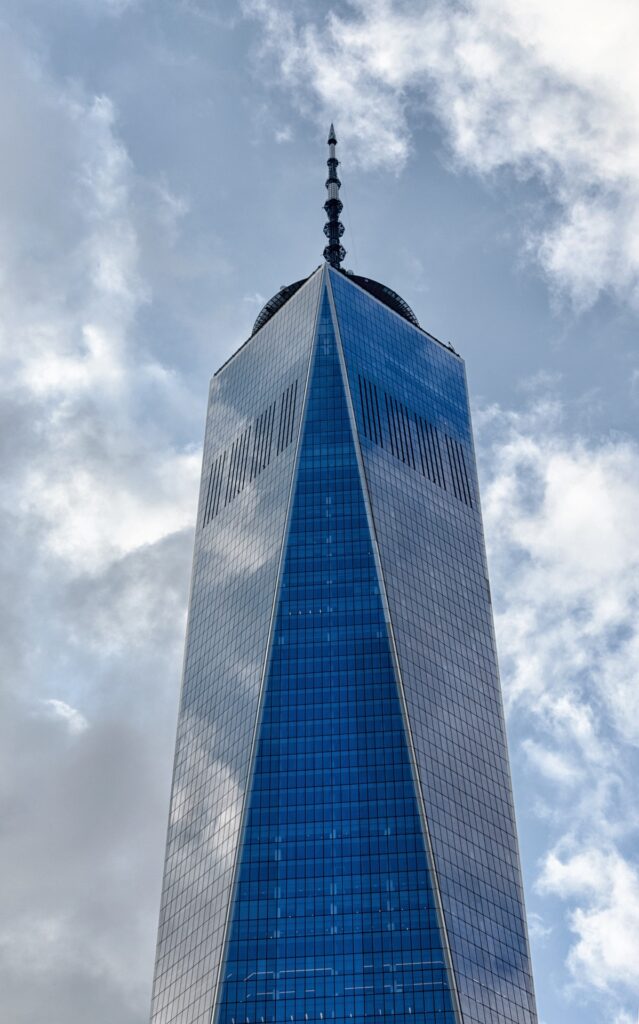
One World Trade Center Image by Simon from Pixabay
Here are some features of the observatory:
- Sky Pod Elevators: The observatory is reached by Sky Pod elevators, which are among the fastest in the world. They bring you to the 102nd floor in less than a minute.
- See Forever Theater: After leaving the elevators on the 102nd floor, visitors first encounter the See Forever Theater, which presents a two-minute video presentation reflecting the unique New York spirit.
- Main Observatory: After the theater presentation, visitors ascend to the 100th floor, known as the Main Observatory. This floor features various digital displays and dining options. The main attraction is the breathtaking 360-degree view of New York City.
- City Pulse: An interactive skyline concierge that gives guests the opportunity to deeply explore the city’s landmarks with close-up views and interesting trivia.
- Sky Portal: Visitors can step onto a 14-foot-wide circular disc in the floor that delivers an unforgettable view, using real-time, high-definition footage of the streets below.
- Dining: The observatory also houses restaurants like the ONE Dine and ONE Mix bar, where you can have a meal or a drink with a stunning view.
It’s an important tourist attraction, offering a truly unique perspective on the city. Just note that access to the observatory requires a ticket, which you can typically purchase in advance online or on site.
The World Trade Center station (also known as World Trade Center Transportation Hub) is a terminal station on the PATH (Port Authority Trans-Hudson) system. Located in the Financial District neighborhood of Manhattan, New York City, it is one of two PATH termini in Manhattan, the other being 33rd Street station.

World Trade Center Station (PATH)
This station is a major transportation hub for the area, connecting PATH trains to New Jersey with New York City Subway services, the Battery Park City Ferry Terminal, and numerous city and regional bus routes.
The original station was destroyed in the September 11, 2001 attacks. A temporary station was opened in 2003 while the permanent one was being built. The current station, which cost approximately four billion dollars, opened on March 3, 2016. The station was designed by architect Santiago Calatrava and is housed in the “Oculus” structure.
The Oculus structure, with its distinct white “ribs,” is a significant feature of the station. It consists of white steel and glass, and its design is meant to resemble a bird being released from a child’s hand. The roof was originally designed to mechanically open to increase light and ventilation to the enclosed space, but this feature is not operational
The station houses the Westfield World Trade Center mall, and its concourses connect various downtown buildings, subway stations, and the PATH system. It serves as a symbol of renewal and progress in the area that was severely affected by the 9/11 attacks.
Day 2:
In the morning, you can start at Times Square in Midtown Manhattan, the “Crossroads of the World”. Then, walk to the nearby Bryant Park, a lovely urban park with the beautiful New York Public Library next to it.

Times Square is a major commercial intersection, tourist destination, entertainment center, and neighborhood in the Midtown Manhattan section of New York City. Named after the New York Times, which moved its headquarters to the Times Building (now known as One Times Square) in 1904, it’s one of the world’s busiest pedestrian areas and a major center of the world’s entertainment industry.
Times Square is well known for its bright, bustling atmosphere, digital billboards, and electric energy. The area hosts many high-profile events, the most famous of which is probably the annual New Year’s Eve ball drop. Each year, hundreds of thousands of people gather in Times Square to watch a large, lit crystal ball descend a pole atop One Times Square to mark the arrival of the new year.
Key Features of Times Square:
- Broadway Theaters: Times Square is best known for being the hub of the Broadway Theater District, where you’ll find many of the city’s famous theaters that host popular plays, musicals, and productions.
- Billboards: The square is filled with enormous digital billboards that light up the area 24/7, making it one of the most visually striking areas in the city.
- Shopping and Dining: There are countless restaurants, cafes, shops, and food vendors in the area, making it a major hub for shopping and dining.
- Pedestrian Plazas: In recent years, parts of Times Square have been closed off to vehicular traffic and turned into pedestrian plazas with seating, tables, and public art installations.
- TKTS Discount Booth: This is a popular spot to buy discounted tickets for same-day Broadway and Off-Broadway shows.
- Street Performers: Times Square is also known for its variety of street performers, who add a unique flavor to the area’s atmosphere.
Times Square is not only a must-see destination for tourists but also a bustling area for New Yorkers who work in the area or are attending Broadway shows.
In the late morning, you can stroll down 5th Avenue, famous for its high-end shopping, towards Rockefeller Center. If you’re up for it, go to the “Top of the Rock” for another perspective of the city.
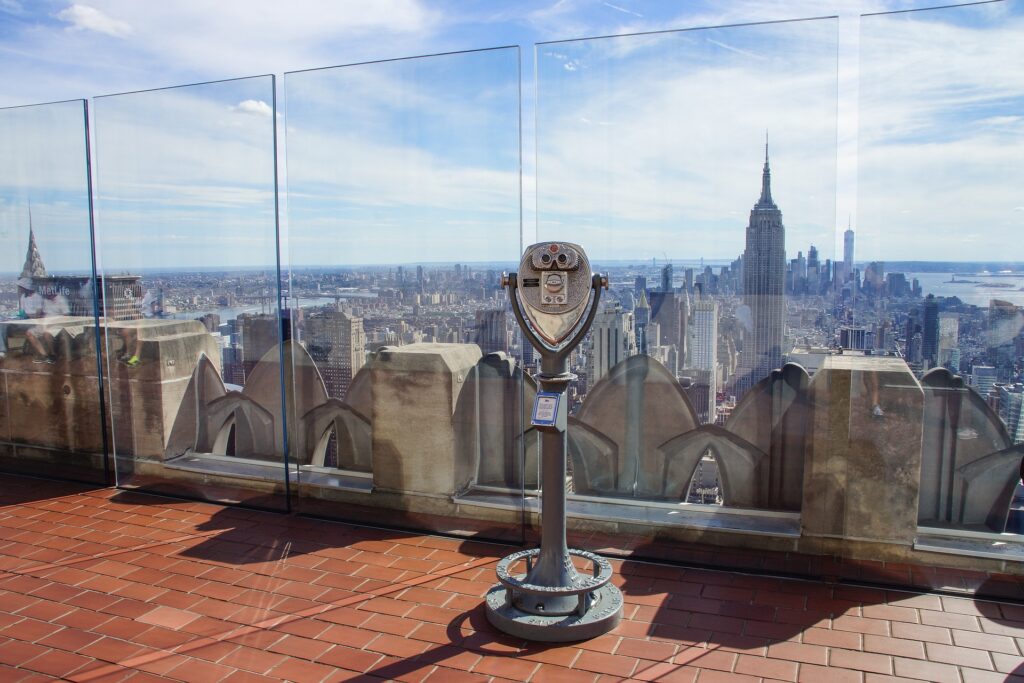
Image by Frank Nürnberger from Pixabay

Rockefeller Center Image by nadinejoos from Pixabay
Rockefeller Center is a large complex consisting of 19 commercial buildings covering 22 acres (89,000 m2) between 48th Street and 51st Street in Midtown Manhattan, New York City. The 14 original Art Deco buildings, commissioned by the Rockefeller family, span the area between Fifth Avenue and Sixth Avenue, split by a large sunken square and a private street called Rockefeller Plaza.
The complex was completed in 1939 and is considered a masterpiece of Art Deco design. The centerpiece of the complex is the 70-story, 872-foot (266 m) 30 Rockefeller Plaza (“30 Rock”), formerly known as the RCA Building, and now also called the Comcast Building. It’s home to the NBC television network and known for the popular TV show “Saturday Night Live”.
An annual tradition at Rockefeller Center is the Christmas tree lighting, which garners national attention each year. Another notable feature is the skating rink located in the sunken plaza.
Rockefeller Center is a significant example of a private project, multi-use, urban redevelopment initiative, representing a combination of two building types: a high-rise office tower and a low-rise pedestrianized concourse.
John D. Rockefeller Jr. initially financed the Rockefeller Center, and it was named after him. It is a landmark for both architecture and integrated urban planning. The buildings are home to numerous works of art, and are an example of the Art Deco style and its desire to create modern, stylized works that are also representative of social and economic order.
Have lunch in the area or grab something to-go and enjoy it in Central Park.
In the afternoon, you can explore Central Park. Because the next attraction is the Metropolitan Museum of Art, you need to find the business hours of the Museum. One weekday is closed and the closing time for other weekdays varies, either 5:00pm or 9:00pm. Once you know the business hours of the Museum, you can decide how much time you should spend in Central park.
Don’t miss sights like the Bethesda Fountain, Strawberry Fields, and the Central Park Zoo.
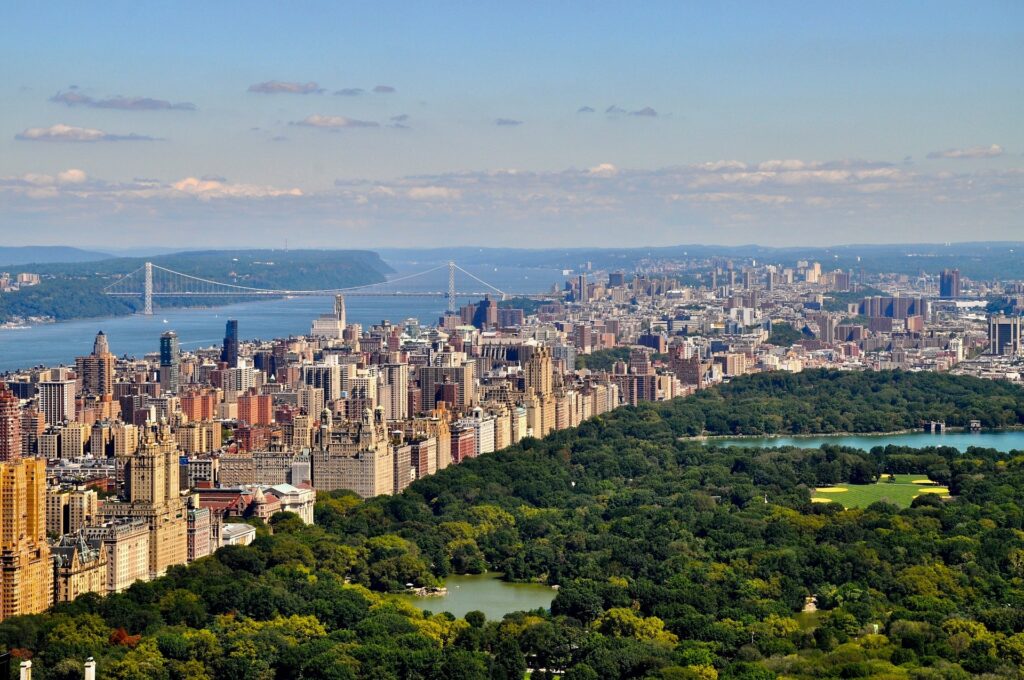
Bethesda Fountain is a prominent landmark located in New York City’s Central Park. It is one of the most well-known and beloved fountains in the park. The fountain is named after the Bethesda Terrace, which is the architectural structure that surrounds it.

Image by Howard Ho from Pixabay
The fountain was designed by Emma Stebbins, a female sculptor, and was unveiled in 1873. It features a large, neoclassical-style sculpture of a winged angel or “Angel of the Waters” standing on top of the fountain’s central column. The angel carries a lily in one hand, representing purity, and blesses the water with the other hand.
The Bethesda Fountain is located at the heart of Central Park, near 72nd Street. It is positioned on the lower level of the Bethesda Terrace, which is a grand staircase that leads down to the fountain. The terrace and fountain serve as a gathering place for visitors and locals alike, offering a tranquil and picturesque setting.
The fountain and its surroundings have been featured in numerous films, TV shows, and photographs, making it an iconic symbol of Central Park. It has become a popular spot for visitors to relax, take photos, and enjoy the scenic beauty of the park.
After Central Park, you can visit the Metropolitan Museum of Art, which stays open late on some weekends. As we mentioned before, you should know the business hours of the museum before visiting Central Park.
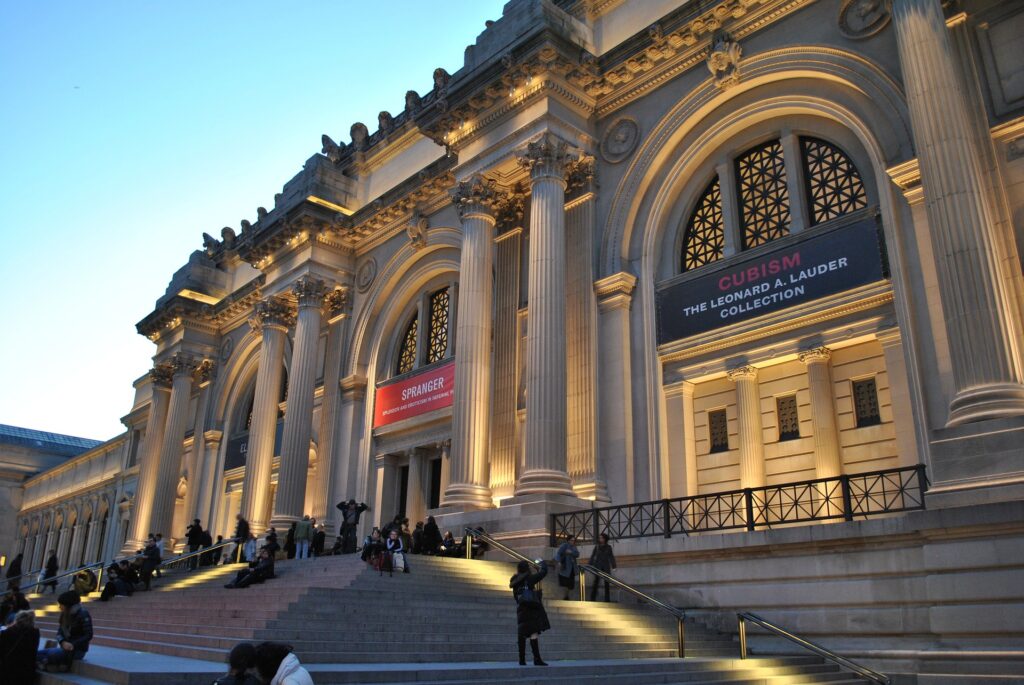
The Metropolitan Museum of Art New York
Image by anielbaez0 from Pixabay
The Metropolitan Museum of Art, often referred to as the Met, is one of the world’s largest and most renowned art museums. It is located in New York City, specifically on the eastern edge of Central Park along Fifth Avenue.
The museum was founded in 1870 and has since become a cultural landmark in the city. Its permanent collection houses over two million works of art spanning various periods and cultures, including ancient Egyptian artifacts, Greek and Roman sculptures, European paintings and sculptures, Asian art, Islamic art, African art, American art, and much more.

The Met occupies a vast complex of buildings, with its main building being a Beaux-Arts architectural masterpiece. The main entrance is marked by the iconic grand staircase leading up to the Great Hall, where visitors can find information desks, a museum shop, and a café. The museum is divided into different departments and galleries, each dedicated to specific art genres or regions.
In addition to its permanent collection, the Met hosts a wide range of temporary exhibitions, showcasing significant works of art from around the world. The museum also offers educational programs, lectures, performances, and events for visitors of all ages.
The Met attracts millions of visitors each year, making it one of the most visited museums globally. Its vast collection and diverse exhibitions make it a must-visit destination for art enthusiasts, scholars, and anyone interested in exploring the rich history of human creativity.
For dinner, try one of the many restaurants on the Upper East Side.
Day 3:
- Greenwich Village in Lower Manhattan
- Washington Square Park
- SoHo
- The Statue of Liberty or/ Williamsburg in Brooklyn
- Brooklyn Bridge Park
in the morning, you can start your day at Greenwich Village, where you can enjoy breakfast at one of the many charming cafés. It is known for its bohemian atmosphere, rich cultural history, and diverse community.
Greenwich Village gained prominence in the 20th century as a hub for artists, writers, musicians, and intellectuals. It was the birthplace of the Beat movement and served as a focal point for the counterculture movement in the 1950s and 1960s. Many famous artists and writers, such as Bob Dylan, Allen Ginsberg, and Andy Warhol, lived and worked in the Village during that time.
The neighborhood is characterized by its tree-lined streets, historic townhouses, and low-rise buildings. It has a unique character with a mix of residential, commercial, and entertainment spaces. Washington Square Park, located in the heart of Greenwich Village, is a popular gathering spot known for its iconic arch, street performers, and vibrant atmosphere.
In the late morning, you can take a stroll through Washington Square Park. It is one of the most iconic and historically significant parks in the city.

Image by Robert Pastryk from Pixabay
The park is named after George Washington, the first President of the United States. It covers an area of approximately 9.75 acres and is situated near New York University (NYU). The park has a rich history dating back to the 19th century and has served as a gathering place for locals, artists, activists, and students.
One of the most recognizable features of Washington Square Park is the Washington Square Arch, a marble triumphal arch located at the park’s northern gateway. The arch was inspired by the Arc de Triomphe in Paris and was designed by architect Stanford White. It serves as a symbol of the park and has become an iconic landmark in the city.
The park offers various amenities and attractions for visitors. It has pathways, lawns, and gardens, providing a peaceful oasis in the bustling city. There are benches and seating areas where people can relax, read a book, or enjoy a picnic. The park also has a central fountain, known as the Washington Square Park Fountain or the “The Garibaldi Statue,” which is a popular spot for people to gather and cool off during the summer months.
Washington Square Park has a vibrant atmosphere and is known for its lively street performances, musicians, and artists. It has a long history of hosting public gatherings, protests, and events, and continues to be a place where people express their ideas and engage in social and political activism.
Then head towards Soho for some shopping. you can have lunch at one of Soho’s chic restaurants.
SoHo, short for “South of Houston Street,” is a trendy and fashionable neighborhood located in Lower Manhattan, New York City. It is renowned for its artistic heritage, upscale shopping, distinctive architecture, and vibrant atmosphere.
SoHo is bounded by Houston Street to the north, Canal Street to the south, Crosby Street to the east, and Sixth Avenue to the west. The neighborhood is characterized by its iconic cast-iron buildings, which were originally industrial warehouses and have now been converted into residential lofts, galleries, boutiques, and restaurants.
One of the main attractions of SoHo is its shopping scene. The neighborhood is home to numerous high-end fashion boutiques, luxury brands, and art galleries. Many international designers and flagship stores have set up shop in SoHo, making it a paradise for fashion enthusiasts and shoppers.
In addition to shopping, SoHo is known for its thriving art scene. The neighborhood has a long history of attracting artists and creative professionals, with many galleries showcasing contemporary art, photography, and design. The annual SoHo Arts Festival brings together artists, performers, and art lovers for a celebration of creativity.
SoHo is also famous for its cobblestone streets, which add to its charm and character. The streets are lined with trendy cafes, restaurants, and bars, offering a wide range of culinary experiences, from casual eateries to upscale dining.
In the afternoon, it is a good time to visit the Statue of Liberty. If you have not reserved tickets in advance, you can explore Williamsburg.
The Statue of Liberty is located on Liberty Island in New York Harbor. It is part of the Statue of Liberty National Monument, which also includes nearby Ellis Island. Both islands can be visited on the same trip.

Image by Monica Volpin from Pixabay
To access the Statue of Liberty’s pedestal or crown, you’ll need to reserve tickets in advance. These tickets can be purchased through the official National Park Service website or authorized ticket vendors. It’s recommended to book your tickets well in advance, especially during peak tourist seasons.
if you have made reservations to visit the Statue of Liberty, just head to Battery Park in Lower Manhattan to take a ferry. The ferry ride offers scenic views of the Manhattan skyline and the Statue of Liberty itself. You can also choose to take a guided tour that includes transportation and a guide.
One of the other options without the Statue of Liberty reservation is that you can take the subway to Brooklyn and explore Williamsburg. This hip neighborhood is known for its vibrant arts scene, hipster culture, trendy shops, and diverse community.
Williamsburg has undergone significant transformation over the years. It was traditionally a working-class and industrial area but has evolved into a popular destination for young professionals, artists, and creatives. The neighborhood has retained some of its industrial charm with converted warehouses and factories now housing galleries, lofts, and creative spaces.
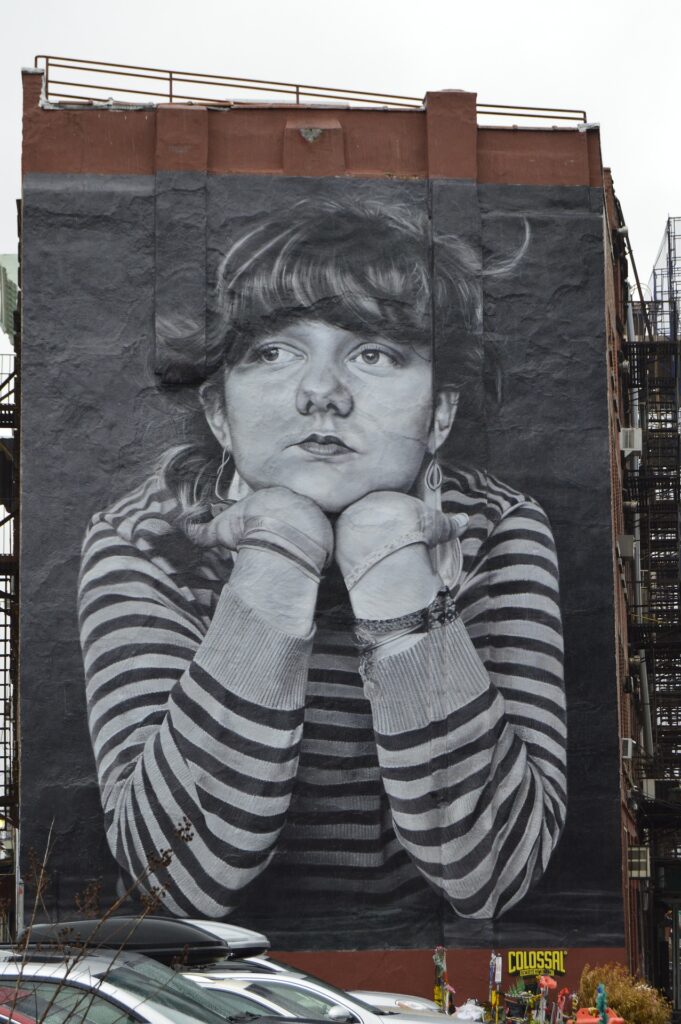
Image by Jared Soto from Pixabay
One of the main attractions of Williamsburg is its thriving arts and music scene. The neighborhood is home to numerous art galleries, music venues, and performance spaces. It has become a hub for emerging artists, musicians, and designers, with frequent art exhibitions, live music shows, and cultural events taking place.
Bedford Avenue, the neighborhood’s main thoroughfare, is lined with an eclectic mix of boutiques, vintage shops, independent bookstores, and specialty stores. The area is known for its unique fashion sense and trendy shopping options. Additionally, the neighborhood boasts a vibrant food and dining scene, offering a diverse range of cuisines, from artisanal coffee shops and craft breweries to trendy restaurants and food markets.
Williamsburg also has several parks and waterfront areas, including McCarren Park and East River State Park. These green spaces provide opportunities for outdoor activities, picnics, and stunning views of the Manhattan skyline.
In the evening, you can visit Brooklyn Bridge Park, where you can enjoy stunning views of Manhattan and the Statue of Liberty. Finish off your trip with a hearty dinner at one of Brooklyn’s renowned eateries.
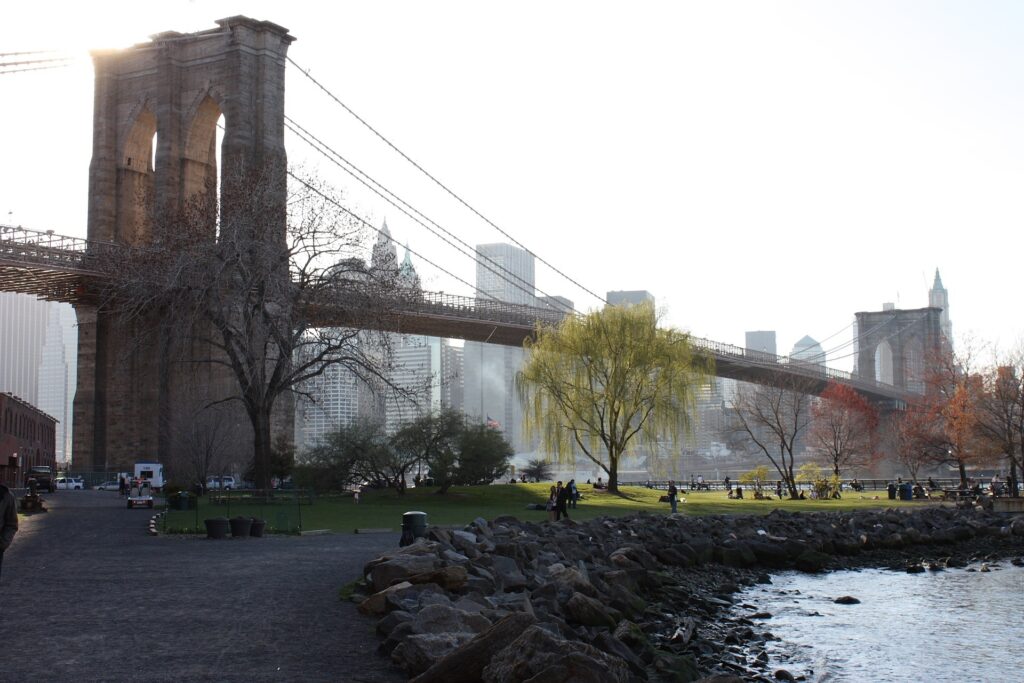
Image by Squidocto from Pixabay
Remember to adjust as necessary based on your personal interests and the weather. Enjoy your trip!
Image by Michael Pewny from Pixabay
